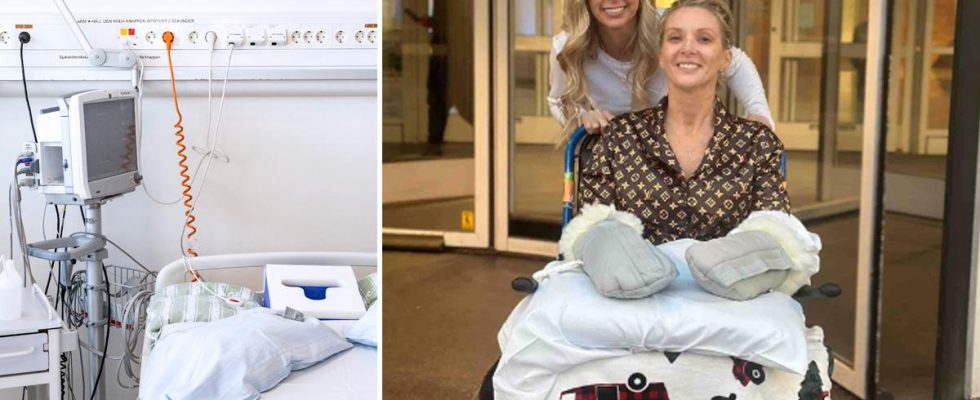Updated 00.37 | Published 00.13
Lucinda, 41, was to have surgery to remove kidney stones and was sedated.
When she woke up, she had lost her legs – and would also have to have her arms amputated.
– I’m just so happy to be alive, says the mother of two, who suffered from sepsis.
Lucinda Mullins, 41, was to have surgery to remove kidney stones. But when the mother of two from Lexington in Kentucky, USA, woke up, she had lost both of her legs – and would also have to have her arms amputated.
She was taken first to Fort Logan Hospital in Stanford and then to a University of Kentucky Hospital by ambulance, writes The Mirror.
Doctors had discovered that the kidney stone had become infected and that Lucinda was suffering from sepsis – blood poisoning caused by invasive A streptococcus which is a life-threatening condition. They were forced to amputate her legs and arms below the elbows.
Lucinda Mullins, who works as a nurse, had been sedated for several days when she woke up and realized what had happened. She tells Lesson 18 that she was calm when the staff told her that they had to amputate in order for her to survive.
– I just said that these are the cards I’ve been dealt and then that’s how we get to play, she says.
– I’m just so happy to be alive. I get to see my children. I get to see my family. I get to have my time with my husband. Everything else is trivial right now.
Collected 1.5 million
In just a few weeks, more than 1.5 million kroner has been collected for Cindy, as Lucinda is called, through a donation page. Among other things, the money will go to adjustments that the family must make in the home to meet her needs, it says on the website.
“We started this fundraiser to support our hero Cindy as well as her husband DJ, who has been by her side every step of the way. Cindy and DJ have two young children who miss their mom and dad terribly,” the page reads.
“Sometimes life is hard and there is no way around it. Cindy and DJ’s world has come to a complete halt, but the world around them continues to move forward. Let’s help ease their burden while they heal and get back to their lives.”
Thanks for the support
Many from the local community had come to the hospital to support Lucinda.
– At one point I think they said 40 people were in the waiting room here. The calls and the texts and the prayers and the things that people have sent. The little words of encouragement – I just can’t understand people doing things like that for me, she tells Lex 18.
Lucinda’s sister Luci Smith posted photos on Facebook of the sisters smiling outside the hospital after the surgery. Lucinda, who was in a wheelchair with bandages, smiles next to her sister who thanked people on Facebook for their support.
“We would like to thank everyone again for all the support, love, prayers, cards, food and visits (her favorite),” Luci Smith wrote.
“You are fantastic. In the next few days we will be moving to Cardinal Hill for a couple of weeks and then coming back for what will hopefully be her final surgery.”
Increases sharply in Sweden
The number of cases of sepsis increased sharply in 2023, which caused the Public Health Agency to alert the healthcare system, reports P4 Kalmar.
Last year, around 1,200 people suffered from sepsis, which is almost 50 percent more than the previous peak in 2018.
The most likely increase is the pandemic, according to Anders Lindblom, doctor at the Public Health Authority.
– We have different habits than we had during the pandemic with few cases. If you do not come into contact with the disease, the immunity becomes worse and therefore we think we will see more cases, he says according to TT.
FACT The sepsis researcher: “Like an atomic bomb”
Around 50,000 adult Swedes suffer from sepsis every year.
Some of the symptoms of sepsis are: high fever, chills, labored breathing, diarrhea, vomiting and body aches.
– Sepsis is an infection that becomes life-threatening. Around 20 percent of those affected die within three months, says Adam Linder, infectious disease physician and sepsis researcher at Lund University.
Adam Linder says that sepsis begins as a local infection. For example, pneumonia, urinary tract infection or wound infection.
– The reason why people with sepsis are forced to amputate is that the body attacks itself. Like an atomic bomb, among other things by the blood vessels starting to leak.
– Then blood clots form in the body, which leads to low blood pressure and lack of oxygen. Then the body prioritizes the brain and heart, which means that the oxygen to the hands and feet is cut off. Then you may have to amputate because the body parts die and rot.
A person who experiences at least three of the symptoms of sepsis should seek care, says Adam Linder.
– Just because you have these particular symptoms does not necessarily mean that you have had sepsis, but regardless, it can be good to seek care.
Read more
